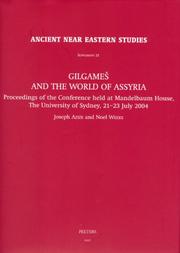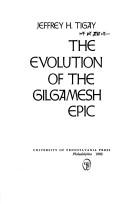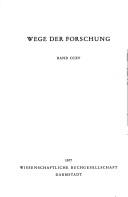| Listing 1 - 10 of 14 | << page >> |
Sort by
|
Book
ISBN: 3769615719 9783769615715 Year: 1993 Volume: 1993/4 Publisher: München : Bayerische Akademie der Wissenschaften,
Abstract | Keywords | Export | Availability | Bookmark
 Loading...
Loading...Choose an application
- Reference Manager
- EndNote
- RefWorks (Direct export to RefWorks)
Gilgamesh --- Epic of Gilgamesh --- Ghilgameš --- Gilgamesch --- Gilgamesz --- Gilgāmish --- Guilgamesh --- Ishtar and Izdubar --- Ishtar (Assyro-Babylonian epic) --- Izdubar --- Jiljāmish --- Kilkāmish --- Sha naqba imura --- Criticism, Textual. --- Translations into German. --- Criticism, Textual --- Translations into German --- Litterature sumerienne

ISBN: 9789042918023 9042918020 Year: 2007 Volume: 21 Publisher: Leuven Peeters
Abstract | Keywords | Export | Availability | Bookmark
 Loading...
Loading...Choose an application
- Reference Manager
- EndNote
- RefWorks (Direct export to RefWorks)
Gilgamesh --- Assyria --- Assyrie --- Congresses. --- Congrès --- 222.2 --- 299.219 --- Genesis --- Godsdiensten van Babyloniërs en Assyriërs --- Conferences - Meetings --- 299.219 Godsdiensten van Babyloniërs en Assyriërs --- Congrès --- Epic of Gilgamesh --- Ghilgameš --- Gilgamesch --- Gilgamesz --- Gilgāmish --- Guilgamesh --- Ishtar and Izdubar --- Ishtar (Assyro-Babylonian epic) --- Izdubar --- Jiljāmish --- Kilkāmish --- Sha naqba imura --- Assur (Kingdom) --- Asshur (Kingdom) --- Congresses
Book
ISBN: 9789004178489 9004178481 9786612950674 9047440838 1282950673 9789047440833 9781282950672 6612950676 Year: 2010 Volume: 39 Publisher: Leiden Boston Brill
Abstract | Keywords | Export | Availability | Bookmark
 Loading...
Loading...Choose an application
- Reference Manager
- EndNote
- RefWorks (Direct export to RefWorks)
The Akkadian Gilgamesh Epic, perhaps the most famous of Mesopotamian literature, has been considered the artistry of one author inspired by Sumerian tales. Specialists have assumed that all the earliest evidence (ca. 1800-1700 BCE) reflects this creative unity. Deep contrasts in characterization and narrative logic, however, distinguish the central adventure to defeat the monster Huwawa from what precedes and follows it. The Huwawa narrative stands on its own, so that the epic must have been composed from this prior Akkadian composition. Recognition of the tale embedded in the epic allows each block of material to be understood on its own terms. Such literary-historical investigation from contemporary texts is new to Assyriology and may produce important results when applied to other Mesopotamian writing. 'The book is well written and tightly argued...This makes it a first point of reference for anyone interested in the OB evidence for the Gilgamesh Epic.' Scott C. Jones, Covenant College
Assyriology --- Epic poetry, Assyro-Babylonian --- History. --- History and criticism. --- Gilgamesh. --- History and criticism --- History --- Gilgamesh --- Assyro-Babylonian epic poetry --- Assyro-Babylonian poetry --- Assyro-Babylonian studies --- Epic of Gilgamesh --- Ghilgameš --- Gilgamesch --- Gilgamesz --- Gilgāmish --- Guilgamesh --- Ishtar and Izdubar --- Ishtar (Assyro-Babylonian epic) --- Izdubar --- Jiljāmish --- Kilkāmish --- Sha naqba imura

ISBN: 0812278054 9780812278057 Year: 1982 Publisher: Philadelphia (Pa.): University of Pennsylvania Press
Abstract | Keywords | Export | Availability | Bookmark
 Loading...
Loading...Choose an application
- Reference Manager
- EndNote
- RefWorks (Direct export to RefWorks)
Epic poetry, Assyro-Babylonian --- History and criticism --- Gilgamesh --- -Assyro-Babylonian epic poetry --- Assyro-Babylonian poetry --- History and criticism. --- Gilgamesh. --- -History and criticism --- Assyro-Babylonian epic poetry --- Epic of Gilgamesh --- Ghilgameš --- Gilgamesch --- Gilgamesz --- Gilgāmish --- Guilgamesh --- Ishtar and Izdubar --- Ishtar (Assyro-Babylonian epic) --- Izdubar --- Jiljāmish --- Kilkāmish --- Sha naqba imura --- Epic poetry, Assyro-Babylonian - History and criticism
Book
ISBN: 9780521509794 9781139048736 0521509793 1108749925 1316399052 1316396851 1139048732 1316399591 1316400131 1316398471 1316393615 1108994105 Year: 2016 Publisher: Cambridge Cambridge University Press
Abstract | Keywords | Export | Availability | Bookmark
 Loading...
Loading...Choose an application
- Reference Manager
- EndNote
- RefWorks (Direct export to RefWorks)
This book provides a groundbreaking reassessment of the prehistory of Homeric epic. It argues that in the Early Iron Age bilingual poets transmitted to the Greeks a set of narrative traditions closely related to the one found at Bronze-Age Hattusa, the Hittite capital. Key drivers for Near Eastern influence on the developing Homeric tradition were the shared practices of supralocal festivals and venerating divinized ancestors, and a shared interest in creating narratives about a legendary past using a few specific storylines: theogonies, genealogies connecting local polities, long-distance travel, destruction of a famous city because it refuses to release captives, and trying to overcome death when confronted with the loss of a dear companion. Professor Bachvarova concludes by providing a fresh explanation of the origins and significance of the Greco-Anatolian legend of Troy, thereby offering a new solution to the long-debated question of the historicity of the Trojan War.
Epic poetry, Greek --- Hittites --- Hittite literature --- History and criticism --- Religion --- Homer. --- Gilgamesh --- Homer --- Epic poetry, Greek - History and criticism --- Hittites - Religion --- Hittite literature - History and criticism --- Homer - Iliad --- History and criticism. --- Religion. --- Gilgamesh. --- Epic of Gilgamesh --- Ghilgameš --- Gilgamesch --- Gilgamesz --- Gilgāmish --- Guilgamesh --- Ishtar and Izdubar --- Ishtar (Assyro-Babylonian epic) --- Izdubar --- Jiljāmish --- Kilkāmish --- Sha naqba imura
Book
ISBN: 0801463424 0801463416 9780801463419 0801450357 9780801450358 1322505675 Year: 2011 Publisher: Ithaca, NY
Abstract | Keywords | Export | Availability | Bookmark
 Loading...
Loading...Choose an application
- Reference Manager
- EndNote
- RefWorks (Direct export to RefWorks)
The world's oldest work of literature, the Epic of Gilgamesh recounts the adventures of the semimythical Sumerian king of Uruk and his ultimately futile quest for immortality after the death of his friend and companion, Enkidu, a wildman sent by the gods. Gilgamesh was deified by the Sumerians around 2500 BCE, and his tale as we know it today was codified in cuneiform tablets around 1750 BCE and continued to influence ancient cultures-whether in specific incidents like a world-consuming flood or in its quest structure-into Roman times. The epic was, however, largely forgotten, until the cuneiform tablets were rediscovered in 1872 in the British Museum's collection of recently unearthed Mesopotamian artifacts. In the decades that followed its translation into modern languages, the Epic of Gilgamesh has become a point of reference throughout Western culture.In Gilgamesh among Us, Theodore Ziolkowski explores the surprising legacy of the poem and its hero, as well as the epic's continuing influence in modern letters and arts. This influence extends from Carl Gustav Jung and Rainer Maria Rilke's early embrace of the epic's significance-"Gilgamesh is tremendous!" Rilke wrote to his publisher's wife after reading it-to its appropriation since World War II in contexts as disparate as operas and paintings, the poetry of Charles Olson and Louis Zukofsky, novels by John Gardner and Philip Roth, and episodes of Star Trek: The Next Generation and Xena: Warrior Princess.Ziolkowski sees fascination with Gilgamesh as a reflection of eternal spiritual values-love, friendship, courage, and the fear and acceptance of death. Noted writers, musicians, and artists from Sweden to Spain, from the United States to Australia, have adapted the story in ways that meet the social and artistic trends of the times. The spirit of this capacious hero has absorbed the losses felt in the immediate postwar period and been infused with the excitement and optimism of movements for gay rights, feminism, and environmental consciousness. Gilgamesh is at once a seismograph of shifts in Western history and culture and a testament to the verities and values of the ancient epic.
Assyro-Babylonian literature. --- Ancient History & Classical Studies. --- LITERARY CRITICISM / Ancient & Classical. --- Akkadian literature --- Babylonian literature --- Gilgamesh --- Gilgamesh. --- Epic of Gilgamesh --- Ghilgameš --- Gilgamesch --- Gilgamesz --- Gilgāmish --- Guilgamesh --- Ishtar and Izdubar --- Ishtar (Assyro-Babylonian epic) --- Izdubar --- Jiljāmish --- Kilkāmish --- Sha naqba imura --- Influence. --- Adaptations.
Book
ISBN: 9781614518549 1614518548 161451545X 1614517088 1614515468 Year: 2014 Publisher: Berlin/Boston
Abstract | Keywords | Export | Availability | Bookmark
 Loading...
Loading...Choose an application
- Reference Manager
- EndNote
- RefWorks (Direct export to RefWorks)
Alhena Gadotti offers a much needed new edition of the Sumerian composition Gilgamesh, Enkidu, and the Netherworld, last published by Aaron Shaffer in his 1963 doctoral dissertation. Since then, several new manuscripts have come to light, prompting not only a new edition of the text, but also a re-examination of the composition. In this book, Gadotti argues that Gilgamesh, Enkidu, and the Netherworld was the first, not the last of the Sumerian stories about Gilgamesh. She also suggests that a Sumerian Gilgamesh Cycle, currently only attested in old Babylonian manuscripts (ca. 18th century BCE), was in fact developed during the Ur III period (ca. 2100-2000 BCE). Providing a new way to look at the Sumerian Gilgamesh stories, this book is relevant not only to scholars of the ancient Near East, but also to anyone interested in epic and epic cycle.
Epic poetry, Assyro-Babylonian --- Epic poetry, Sumerian --- Sumerian epic poetry --- Sumerian poetry --- Assyro-Babylonian epic poetry --- Assyro-Babylonian poetry --- History and criticism. --- Gilgamesh. --- Epic of Gilgamesh --- Ghilgameš --- Gilgamesch --- Gilgamesz --- Gilgāmish --- Guilgamesh --- Ishtar and Izdubar --- Ishtar (Assyro-Babylonian epic) --- Izdubar --- Jiljāmish --- Kilkāmish --- Sha naqba imura --- Ancient Near Eastern epic. --- Mesopotamian literature. --- Sumerian literature.
Book
ISBN: 9783727816864 3525543662 3727816864 9783525543665 Year: 2010 Volume: 245 Publisher: Fribourg Academic Press
Abstract | Keywords | Export | Availability | Bookmark
 Loading...
Loading...Choose an application
- Reference Manager
- EndNote
- RefWorks (Direct export to RefWorks)
"This collection of articles has two aims: The first is to create a comprehensive compendium of iconography on Gilgamesh, that includes three formerly published and several new papers on the visual representation of Gilgamesh. The second is to publish some objects of Near Eastern art from the Bible+Orient Collection in Fribourg, which relate to Gilgamesh."--Summary.
Gilgamesh (Legendary character) --- Art, Assyro-Babylonian. --- Art. --- Gilgamesh --- Criticism, interpretation, etc. --- Art, Assyro-Babylonian --- 892.1 --- 73.046 --- 82:7 --- 82:7 Literatuur en kunst --- Literatuur en kunst --- 73.046 Mythologie; religie; epiek in de beeldhouwkunst --- Mythologie; religie; epiek in de beeldhouwkunst --- 892.1 Akkadische, Sumerische literatuur --- Akkadische, Sumerische literatuur --- Art, Babylonian --- Assyro-Babylonian art --- Babylonian art --- Epic of Gilgamesh --- Ghilgameš --- Gilgamesch --- Gilgamesz --- Gilgāmish --- Guilgamesh --- Ishtar and Izdubar --- Ishtar (Assyro-Babylonian epic) --- Izdubar --- Jiljāmish --- Kilkāmish --- Sha naqba imura

ISBN: 3534044576 9783534044573 Year: 1977 Volume: 215 Publisher: Darmstadt Wissenschaftliche Buchgesellschaft
Abstract | Keywords | Export | Availability | Bookmark
 Loading...
Loading...Choose an application
- Reference Manager
- EndNote
- RefWorks (Direct export to RefWorks)
Gilgamesh --- Epic poetry, Assyro-Babylonian --- History and criticism --- 892.1 --- -Assyro-Babylonian epic poetry --- Assyro-Babylonian poetry --- Akkadische, Sumerische literatuur --- History and criticism. --- Gilgamesh. --- -Akkadische, Sumerische literatuur --- -892.1 Akkadische, Sumerische literatuur --- Assyro-Babylonian epic poetry --- 892.1 Akkadische, Sumerische literatuur --- Epic of Gilgamesh --- Ghilgameš --- Gilgamesch --- Gilgamesz --- Gilgāmish --- Guilgamesh --- Ishtar and Izdubar --- Ishtar (Assyro-Babylonian epic) --- Izdubar --- Jiljāmish --- Kilkāmish --- Sha naqba imura --- Epic poetry, Assyro-Babylonian - History and criticism
Book
ISBN: 9781108481786 9781108667968 9781108723251 1108667961 1108639356 1108481787 Year: 2019 Publisher: Cambridge, England : Cambridge University Press,
Abstract | Keywords | Export | Availability | Bookmark
 Loading...
Loading...Choose an application
- Reference Manager
- EndNote
- RefWorks (Direct export to RefWorks)
It is widely recognised that the epics of Homer are closely related to the earlier mythology and literature of the Ancient Near East, above all the Babylonian Epic of Gilgamesh. But how should this influence our response to the meaning and message of either poem? This book responds to this question through an experiment in intertextual reading. It begins by exploring Gilgamesh as a work of literature in its own right, and uses this interpretation as the springboard for a new reading of the Homeric epic, emphasising the movement within the poem - beginning from a world of heroic action and external violence, but shifting inwards to the thoughts and feelings of Achilles as he responds to the certainty that his own death will follow that of his best friend. The book will be of interest both to specialists and to those coming to ancient literature for the first time.
Homer. --- Achilles --- Gilgamesh --- In literature. --- Gilgamesh. --- Literature. --- Achilles, --- Gilgamesh, --- Iliad (Homer). --- Achìe --- Achilas --- Achille --- Achilleus --- Achilli --- Ahil --- Ahile --- Ahilej --- Ahillejs --- Aĥilo --- Aichill --- Akhilles --- Akhilleus --- Akhilleusz --- Akiles --- Akili --- Akille --- Akilles --- Akkilles --- Aquiles --- Aquilles --- Axill --- Axilles --- Ἀχιλλεύς --- آخيل --- アキレウス --- Akireusu --- 아킬레우스 --- 阿喀琉斯 --- Ахіл --- Ахил --- Ахилл --- Akhill --- Ахіллес --- אכילס --- Akhiles --- Homer --- Epic of Gilgamesh --- Ghilgameš --- Gilgamesch --- Gilgamesz --- Gilgāmish --- Guilgamesh --- Ishtar and Izdubar --- Ishtar (Assyro-Babylonian epic) --- Izdubar --- Jiljāmish --- Kilkāmish --- Sha naqba imura
| Listing 1 - 10 of 14 | << page >> |
Sort by
|

 Search
Search Feedback
Feedback About UniCat
About UniCat  Help
Help News
News